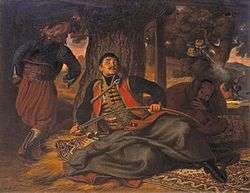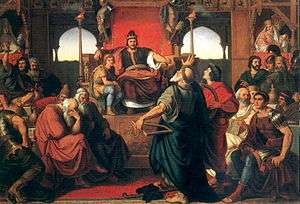Mór Than
Mór Than (19 June 1828 – 11 March 1899) was a Hungarian painter.
Mór Than Than Mór | |
|---|---|
 Contemporaneous etching of Mör Than, by Rusz Károly | |
| Born | Than Mór June 19, 1828 |
| Died | March 11, 1899 (aged 70) |
| Nationality | Hungarian |
Biography
Born at Óbecse (today Bečej, Serbia), Than was educated in Italy and Vienna beside his cooperation with similar famous painters in his homeland. He worked in a realistic – pre-impressionist style. His subjects were mostly historic events and portraits but also mythological or fantasy themes. He painted frescos which decorate several prominent public buildings in Budapest.
Than also designed the first Hungarian postage stamp, which was supposed to be distributed after the Hungarian Revolution of 1848.[1] However, the uprising failed, and Lajos Kossuth's Hungarian State collapsed; the printing presses were subsequently destoyed by Austrian authorities. Than died in Trieszt in 1899.
Gallery
 The Assassination of Karadjordje (1863), National Museum of Serbia
The Assassination of Karadjordje (1863), National Museum of Serbia Young Woman Wearing a Renascence Dress, 1886 (private collection)
Young Woman Wearing a Renascence Dress, 1886 (private collection) The Feast of Attila (1870), at the Hungarian National Gallery, Budapest
The Feast of Attila (1870), at the Hungarian National Gallery, Budapest Portrait of Ágnes Rosty (1865)
Portrait of Ágnes Rosty (1865) Postage stamp design, 1848
Postage stamp design, 1848
References
- Visnyovszki, Gábor (1996). Stamps. Budapest: Állami Nyomda. p. 85.